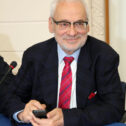
Joanna Rajkowska
Graduate of art history at the Jagiellonian University and of painting at the Academy of Fine Arts in Krakow. She creates sculptures, photographs, objects and installations. She is best known for actions taken in public space – at the borderline of art and reality.
The most important works of Joanna Rajkowska include:
Pozwól, że umyję ci ręce (Allow me to wash your hands, 1994) – a performance staged in New York, repeated several times in later years (Buffalo, 1996; Wrocław, 2008; New York, 2009), when the artist washed the hands of consenting passers-by in iodine.
Satysfakcja gwarantowana (Satisfaction guaranteed, 2000) – the artist created a product line of cosmetics and drinks the ingredients of which were – as noted on the labels – secretions of her body, hormones, fat, DNA, etc. The products included soft drinks in six tastes, two brands of soap, Vaseline and perfumes – all in carefully designed packaging, made by the thousands. This provocation was an artistic fiction, for in fact the products were not based on bodily substances.
Pozdrowienia z Alej Jerozolimskich (Greetings from Jerusalem Avenue, 2002) – placing of a 15-metre high palm tree at the crossing of Aleje Jerozolimskie and Nowy Świat street, at the de Gaulle Roundabout in Warsaw. The palm tree, still standing there, has become a new symbol of the capital.
Dwadzieścia dwa zlecenia (Twenty two tasks, 2003–2005) – within this project (staged in Berlin and in Łódź) the artist could be hired for free to do any work. The chores were, for example, to accompany someone to the airport, to decorate a house for a farewell party or to reinstall a bedroom door upside down. A slide show and a silent film were made on the basis of the documentation of the works.
Dotleniacz (Oxygenator, 2006–2007) – a project realised in the centre of Warsaw. At the Grzybowski Square the artist arranged a pond (about 140 metres square) with water lilies, equipped with machines producing ozone and fog. The water was surrounded with plants, decorative bushes and benches.
Minaret (2009–2011) – a disused chimney in the compound of the former paper mill in Poznań was to be turned into a minaret (the tower was to be only an architectural sign, without any religious functions). The project was abandoned because of protests and unwillingness of the local authorities.


